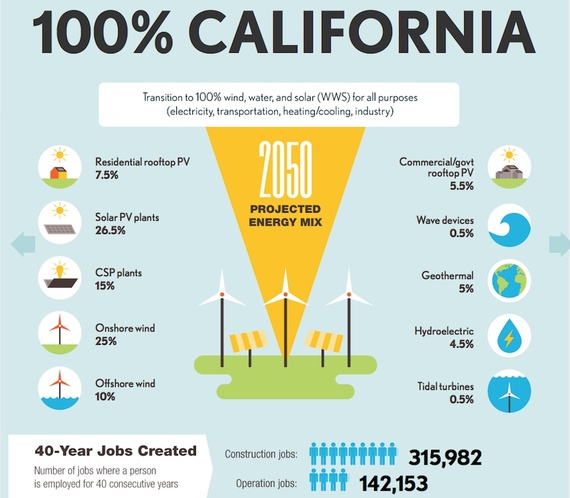
By Don Willlmott
Don Willmott is a New York-based journalist who writes about technology, travel and the environment for a wide variety of publications and websites.
Little by little, it's happening. Perhaps there's a new solar array in Nevada, or a new wind farm in Texas, or geothermal drilling in Wyoming, or a tidal turbine experiment in Maine. A future in which electricity comes from energy sources other than fossil fuels is taking shape, but what would it really take to free the nation from all fossil fuels forever? Is that an attainable goal?
A new study by Mark Z. Jacobson, a professor of civil and environmental engineering at Stanford, and colleagues including U.C. Berkeley researcher Mark Delucchi, is the first to outline precisely how each of the 50 states can replace fossil fuel energy with clean and renewable energy within 35 years. It wouldn't be easy, but the important point the study makes is that the goal could be reached using technologies that exist today. In other words, they say, the future is now.
"The main barriers are social, political, and getting industries to change. One way to overcome the barriers is to inform people about what is possible," Jacobson said in a news release. "By showing that it's technologically and economically possible, this study could reduce the barriers to a large-scale transformation."
The study kicked off by taking a look at the current energy demands of each state and how those demands would change under business-as-usual conditions by the year 2050, analyzing the current amount and source of the fuel consumed and figuring out fuel demands if all fuel usage were replaced with electricity. (Note they assume that all cars, homes, and industries will be electrically powered in the future.)

"When we did this across all 50 states, we saw a 39 percent reduction in total end-use power demand by the year 2050," Jacobson said. "About six percentage points of that is gained through efficiency improvements to infrastructure, but the bulk is the result of replacing current sources and uses of combustion energy with electricity."
Next the scientists figured out how to pump power into the grid in every state, looking at sun exposure, counting south-facing rooftops, studying wind maps, and charting the potential of offshore wind turbines. As for geothermal, they found it comes into play in just 13 states, and the plan calls for no new dams. Interestingly, the plan says that no more than 0.5 percent of any state's land needs to be covered in solar panels or wind turbines.
What's the solution for your state? Just click on The Solution Project's interactive map to find out. You'll see how your state could make an 80 percent transition to fossil-fuel-free electricity by 2030 and a full conversion by 2050. Leaders include Washington State, which already gets more than 70 percent of its electricity from existing hydroelectric sources, and Iowa and South Dakota, which generate nearly 30 percent of their electricity from wind power today. California, Jacobson notes, already has a plan to be 60 percent electrified by renewables by 2030.
Visit XPRIZE at xprize.org; follow us on Facebook, Twitter and Google+; and get our newsletter to stay informed.